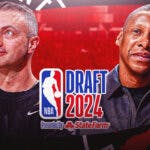After squeaking by the Orlando Magic thanks in part to a heads up defensive play by Gary Trent Jr. at the buzzer Friday night, the Toronto Raptors found themselves in another tight one (after letting another late lead slip) against the Indiana Pacers on the second night of a back-to-back.
This time, the heroics came courtesy of rookie Scottie Barnes, who was intentionally fouled late and sent to the free throw line to try and push Toronto’s advantage to three. There he did just that, sinking the two shots smooth as silk, unmoved by pressure’s weight.
“I loved when it got loud,” Barnes said in the immediate post-game interview. “I smiled a bit at the free throw line. … It was nothing to me.”
The Raptors are now 4-3 and above .500 for the first time this season—here are three key takeaways from the game that got them there:
Fred VanVleet, Midrange Assassin

Every season, Fred VanVleet has taken strides to improve his game. This time around, it appears to have manifested in the form of a new, active focus on scoring in the midrange, an area he has struggled to take advantage of in his career.
That is, of course, not entirely his fault—until this season (one could perhaps make an argument for last season), the midrange simply wasn’t a part of the floor where VanVleet’s game really needed to unfold. He was often playing in units alongside Kyle Lowry or other playmakers, and so his known high-efficiency skills (flying around off-ball, relocating for catch-and-shoot triples) were understandably the priority.
In his current role, however, in which he is being asked to carry a much more significant playmaking burden, taking advantage of the midrange has become a much more necessary element of his game. He’s opened that up by making use of a quick step-back, zipping past screens and then stopping on a dime and reversing to clear himself a bit of space to launch up high-arcing shots.
“It’s just a shot I can get whenever I want,” VanVleet told reporters. “It’s something that I can go to when I need to get one up. The tough part is still trying to run the flow of the offence and just trying to execute things the way coach wants it done.”
Last season, VanVleet took 2.1 midrange pull-up jumpers per game on which he shot just 37.3 percent. Through seven games this season, he’s upped that volume a tad, taking 2.4 of those looks, but he’s increased his efficiency by leaps and bounds, shooting a red-hot 64.7 percent.
“I haven’t really been trying to play a lot of one-on-one,” VanVleet said, “I’ve been trying to play within the flow because I think it makes us a better team if we share it a little bit, but there’s times when I’m gonna have to get my own shot like we saw [against Orlando on Friday] in the fourth.
“Just getting to that pull-up, it’s a shot that’s open on most nights. It’s something I’ve paid a lot of attention to over the last few years, working on that. It’s something I continue to work on and try to develop and get better at.”
In the growing list of positive trends for this Raptors season, VanVleet’s shooting within the arc has to be right near the top.
Sviji lives
Though he’s been playing hard every time he’s touched the hardwood this season, things haven’t gone Svi Mykhailiuk’s way for the most part. Even so, Nurse has kept him in the rotation, keenly aware of the importance his shooting and secondary playmaking bring as release valves to the offense.
“I feel like it always takes time when you come to a new team and there’s a lot of new players,” Mykhailiuk said. “I feel like you’ve gotta get adjusted, gotta learn how everybody plays, gotta learn spacing, how everybody likes to move, where everybody likes to go.”
SVI COOKIN' 'EM 👀 pic.twitter.com/2erphFnvtX
— Toronto Raptors (@Raptors) October 31, 2021
On Saturday, things finally came together for him, and he produced his best performance through six games, finishing with 16 points, four rebounds and two assists on a 73.5 true shooting percentage in 22 minutes.
He played his role to perfection—on defense, he was solid at every turn. On offense, he hit open catch-and-shoot threes, and rather than trying to force creation on his own, he attacked closeouts to get himself on the move and either attempt to score or keep the ball moving. He also kept up the energy on the offensive glass, an area in which he’s been sneakily good this season.
If the Raptors can get more performances like this out of him going forward, it’ll be a significant boost to their lackluster half-court offense.
Toronto Raptors: glass eaters
By now everyone knows that the Raptors do not boast one of the more potent half-court offenses in the league.
But their plan to help mitigate that weakness (namely, offensive rebounding) has proven to be more effective in the early season than might’ve been expected for a team that, despite having a fairly even distribution of players around the height of 6’9”, is relatively undersized.
Get ya weight up
17 Pts | 10 Reb | @ScottBarnes561 pic.twitter.com/MwpSirABUM
— Toronto Raptors (@Raptors) October 31, 2021
“We’re just trying to old school it,” head coach Nick Nurse said. “We’re trying to get more bodies in there than they’ve got, in the paint. We’re trying to get more block outs and when it does finally come up we’re trying to jump little higher and keep balls alive or keep them from getting them on the defensive end. We’re trying to get our share on the offensive end this year and so far we’re doing pretty good with that.”
Toronto presently ranks second in offensive rebounding percentage (34.9), and first in put-back plays generated per 100 misses (22.2). They also sit sixth in put-back points scored per 100 misses (22).
Every time a shot goes up, someone is there, crashing the glass either by way of insane lankiness (which the Raptors have much of) or by well-timed craftiness. It’s an exhaustive way to play, but the Raptors are one of the youngest teams in the league, and it’s working.




